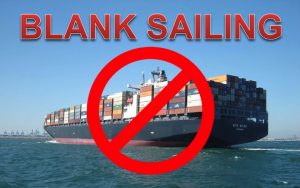Carriers Unveil Q3 Blank Sailings & What it Means

Blank Sailing
With the first half of 2020 marked by COVID-19 shutdowns around the world, first in China and eventually in the U.S., ocean carriers’ biggest strategy for dealing with decreased shipping demand has been utilizing blank sailings. Maersk, the world’s largest ocean carrier by capacity, even managed to post a nearly $200M profit after the first quarter, thanks in large part to blanked sailings.
As we approach the end of the second quarter of 2020, many hope to see a great deal fewer cancellations from carriers in the third quarter. After all, things are starting to open back up. The hope is that shipping demand would return with reopenings. May was even being touted as the peak for blank sailings, and we’d start seeing a decrease in cancellations from here on out. However, carriers just announced a whole slew of blank sailings for Q3.
The 2M and THE Alliance combined have announced 220 blanked sailings for Q3. Greg Knowler reported in a Journal of Commerce article:
THE Alliance of Hapag-Lloyd, Ocean Network Express, Yang Ming, and HMM, and the 2M Alliance of Maersk Line and Mediterranean Shipping Co., this week said 75 sailings will be canceled through September in a bid to match capacity with weak anticipated volume levels.
…
By June 1, before Wednesday’s third quarter network adjustments, the three alliances had announced a total of 126 void sailings on the trades between Asia and North America through August as a result of the impact of the coronavirus on demand, and 94 blanked sailings on Asia-Europe, according to Sea-Intelligence Maritime Consulting.
There are three major carrier alliances that dominate ocean freight shipping. You can bet the Ocean Alliance, the remaining carrier alliance that is between COSCO, CMA CGM, and Evergreen, will be announcing blank sailings to add to the ones from 2M and THE.
While it may not be as big of news to our main base of readers, U.S. shippers, but 2M is also continuing to cancel Asia to Europe service through the third quarter as well. Knowler writes later in his JOC article:
The 2M Alliance will suspend its joint Asia-Europe AE2/Swan and AE20/Dragon services for the full third quarter, removing 22 percent of their capacity from the trade. However, Sea-Intelligence pointed out that a fortnightly “sweeper” service to be deployed by MSC on both the Asia-North Europe and Asia-Med trades in the third quarter would offset the blank sailings, reducing capacity by 15 to 18 percent instead of 22 percent.
Blank Sailings Opportunity to Install Scrubbers
Shippers generally think of blank sailings as a bad thing because they are a decrease in service and can mean delays in receiving import goods or getting export goods to business partners or operations overseas. However, blank sailings, more than anything else, are an indication of demand in the international shipping industry. Thinking of blank sailings that way make them feel closer to neutral news in and of themselves. Right now, there might even be a way to look at the blank sailings going on as good news.
Coming into 2020, we all thought the biggest international shipping news stories would revolve around IMO 2020. The International Maritime Organization’s (IMO) mandate for ships to drop from a 3.5% sulfur cap on fuel emissions to a 0.5% one is very significant. Carriers were racing to get scrubber systems installed in ships, so they would meet the requirement by cleaning the higher sulfur fuel in ships’ engines. As 2019 was ending, it looked like the world fleet was not ready.
Getting scrubbers installed at shipyards was taking longer than expected. That problem was obviously exacerbated by COVID-19 shutdowns. However, the shutdowns slowed demand and caused so many blank sailings that we’re seeing record numbers of idle ships right now. Knowler’s JOC article has numbers on that as well:
Alphaliner has reported that a total of 11.6 percent of the container shipping fleet is now idle, reaching a record 2.72 million TEU by the end of May, with 20 percent of the capacity (64 ships) being fitted with scrubbers.
Decreased demand and, therefore, sailings give the world fleet the opportunity to catch up on scrubber installations, so, despite some controversy around scrubbers, carriers’ ships will be ready to meet IMO 2020 and demand — when demand returns. Now the question is…
When Will Demand Return?
There does not seem to be much optimism for a strong peak season this year. While online shopping demand has increased during the lockdowns and many believe will remain strong after reopening, there is not expected to be a huge jump in demand for shipping as physical stores reopen.
There are a couple reasons that the return of demand is expected to be gradual instead of immediate. One of the reasons is that many businesses are stocked after the lockdowns. Some imported goods early to beat tariff hikes on China (remember when the trade war was the world’s biggest story?). Some simply haven’t been able to sell their inventory because of the shutdown. Then you have unemployment and permanent business closures caused by the lockdowns that look likely to negatively impact overall customer spending and business importing and exporting in a significant way.
Adding these things up could mean a very slow recovery for international shipping demand.
However, there are a great many people who have been pent up but able to continue working from home. As things reopen, many will be wanting to get back into stores and businesses to shop outside of the house. It’s possible there could be a splurge that will help speed recovery and surprise those with a pessimistic view on the return of the economy and the shipping of goods around the world.




